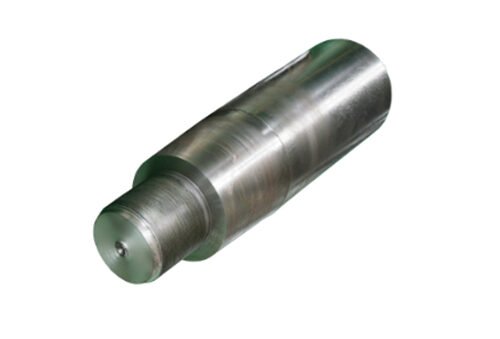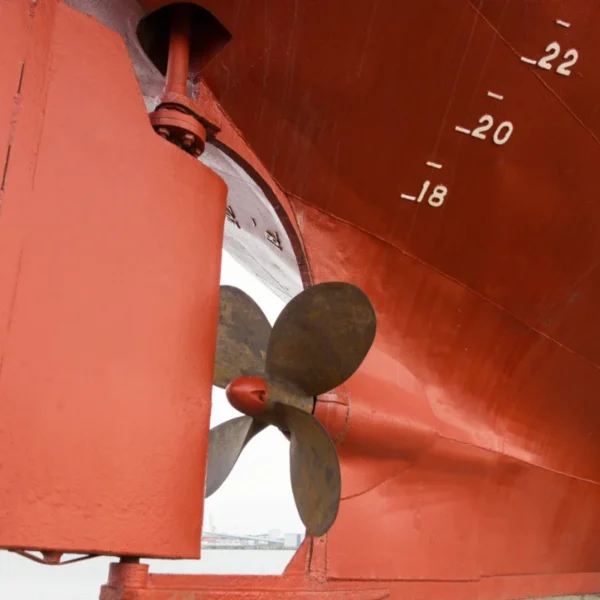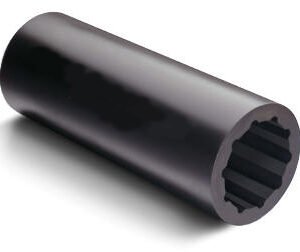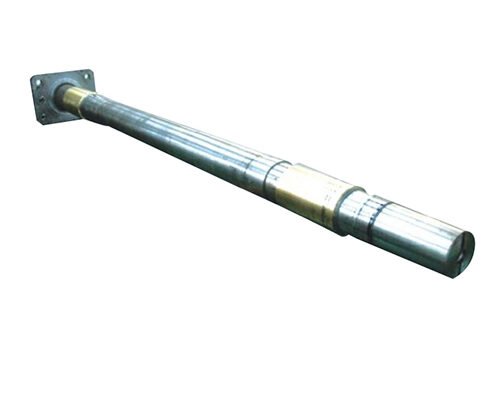The rudder pintle is a crucial component of a ship’s rudder system, serving as the lower pivot point for the rudder blade. It is a vertical pin located at the bottom of the rudder blade that fits into a corresponding fitting on the ship’s stern frame, called the gudgeon. Together, the pintle and gudgeon form a hinge that allows the rudder to turn freely while supporting its weight and the immense forces acting upon it.
Function and Importance
The primary functions of the rudder pintle are:
- Weight Support: The pintle, along with the rudder carrier bearing (on the rudder stock), supports the entire weight of the rudder blade.
- Lateral Force Absorption: As the rudder turns, the pintle-gudgeon assembly resists the significant sideways forces from the water flow, preventing the bottom of the rudder from shifting out of position.
- Pivot Point: The pintle-gudgeon connection serves as the lower pivot point, allowing the rudder blade to rotate smoothly and precisely for steering.
Components and Design
The rudder pintle assembly consists of several key parts:
- Pintle: A forged steel pin, often covered with a bronze or stainless steel sleeve to protect against corrosion and provide a smooth bearing surface. The pintle is securely attached to the rudder blade.
- Gudgeon: A rigid metal casting or fitting, typically bolted or welded to the ship’s stern frame, that houses the pintle bearing.
- Pintle Bearing: This bearing material is located inside the gudgeon and provides the low-friction surface on which the pintle rotates. It is a critical wear component.
- Locking Mechanism: A nut, key, or other locking device is used to secure the pintle to the rudder to prevent it from coming loose or falling out.
Materials
The materials used for the pintle and its bearing are chosen for their strength, durability, and resistance to corrosion and wear in a marine environment.
- Pintle: High-strength forged carbon manganese steel.
- Pintle Bearing: Traditionally, these bearings were made of bronze or lignum vitae (a very dense hardwood). Modern bearings are often made from self-lubricating, environmentally friendly materials like composite polymers or other high-performance, non-metallic materials.
Maintenance and Common Issues
Maintenance of the pintle is crucial for a rudder’s safe operation and is typically performed during dry-docking.
- Bearing Wear: The most common issue is wear in the pintle bearing. The clearance between the pintle and the gudgeon must be measured and kept within specified limits. Excessive clearance can lead to rudder “slap,” vibration, and damage to the pintle itself.
- Corrosion: The pintle and gudgeon are subject to galvanic and crevice corrosion, which must be prevented with proper coatings and sacrificial anodes.
- Damage: The pintle can be damaged from impacts with floating debris or grounding.
Common Spares
A vessel’s spare parts inventory for the rudder pintle focuses on the wearable components.
- Pintle Bearings: A spare set of pintle bearings is a crucial inventory item, as they are a high-wear component that must be replaced during dry-docking if wear limits are exceeded.
- Sleeves: If the pintle is fitted with a replaceable sleeve, a spare sleeve is also required.
- Mounting Hardware: Spare nuts, bolts, and locking pins for securing the pintle and gudgeon.
- Anodes: Sacrificial anodes to prevent corrosion.
The rudder pintle is a small but fundamentally important part of a ship’s rudder system, ensuring the rudder remains structurally sound and responsive under all operating conditions.
We offer an extensive range of marine engine brands and their associated spare parts, providing comprehensive solutions for both main propulsion and auxiliary power needs across diverse vessel types. Our supply capability covers various generations and models, ensuring support for a wide array of marine applications.
Featured Brands and Engine Series/Models:
SULZER:
- Two-Stroke Engines:
- RD/RND Series: RD68, RND76, RND76M, RND90, RND90M (Classic large-bore, low-speed engines, still in operation).
- RLA/RLB Series: RLA(B)56, RLA(B)66, RLA(B)76, RLB90 (Developed two-stroke designs).
- RTA/RT-Flex Series: RTA38, RTA48(T), RTA52, RTA58, RTA62, RTA72, RTA76, RTA84, RTA84M, RTA84C, RTA96 (Modern, fuel-efficient, electronically controlled two-stroke engines).
- Four-Stroke Engines:
- Z Series: ZL40/48, 16ZAV40S (Medium-speed engines).
- RF Series: RF44, RF56 (Often used for auxiliary power or generator sets).
- TAD Series: TAD36, TAD48 (For specific applications).
MAN (including pre and post-MAN B&W models):
- Two-Stroke Engines (KZ, KSZ, K, L, S, MC/MC-C, ME/ME-C): 40/54A, 52/90N, 57/80C, KZ57/80F, KSZ70/125, KSZ78/155, 90/160A, 52/55L, 58/64, 90/190C, L60/105E, 70/120E, 70/125C, L, KSZ78/155A, KSZ70/125B, L52/55A, 40/45 (A broad spectrum covering main propulsion and auxiliary engines).
B&W (Burmeister & Wain – prior to MAN B&W merger):
- MC/MCE Series: L35MC, L60MC, L80MC, L55GFCA, L80GFCA, L80GB, 74VT2BF, K62EF, K74EF, K84EF, K45GFC, K67GFK, K80GFK, K90GFS, 45HU, L70MC (Various generations of two-stroke diesel engines).
- MC-C/ME-C Series: L50MC, S60MC, S70MC, K80MC, S80MC, K90MC-C, L67GFCA, L90GB (Electronically controlled and conventional two-stroke engines).
- VT2BF/EF Series: 50VT2BF, 62VT2BF, K84EF (Older models still in service).
MITSUBISHI:
- UEC/UET Series: UEC37L/LA/LS, UEC45HA, UEC60L/LA/LS, UEC45L/LA/LS, UET45/75C, UEC52/125H, UEC52L/LA/LS, UET45/80D, UEC52/90D, UEC(T)52/105D, UEC45/115H, UEC37/88H, UEC37H (Mitsubishi’s proprietary two-stroke and some four-stroke engine series).
PIELSTICK:
- PA Series: PA6, PC3, PC2-2, IHI PC2-5, PC4, PC2-6, PC4-2L, PC4-570, PA5 (High-speed, compact four-stroke engines, commonly used for generator sets or auxiliary propulsion).
AKASAKA:
- UET/UEC/DM/AH Series: UET45/80D, UEC52/105D, DM51SS, UEC 60/150H, UEC 60H, A31, A34, A37, A41, AH27, AH28, AH30, AH36, AH38, AH40, DM30, DM36, DM38, DM46, DM47 (A prevalent engine brand, particularly in Japanese-built vessels).
DEUTZ:
- RBV/TBD/BVM Series: RBV8M358, RBV8M540, RBV16M640, TBD620L6, BVM350, BVM540, BF6M716 (Various four-stroke medium- and high-speed diesel engines for auxiliary and smaller main propulsion applications).
HANSHIN:
- EL/LH/LU/LUN/LUD/LUS Series: EL30, EL32, EL35, EL40, EL44, LH28RG, LH31G, LU28(A,R,G), LU32, LU35, LU38, LU46(A), LU50, LU54, LUN28, LUN30, LUD32, LUD35, LUS38 (Another significant engine brand commonly found in Japanese vessels).
NIIGATA:
- MG/M Series: MG40X(EX), M34X, 6M28BF, TM31X (Medium-speed diesel engines, typically used in small and medium-sized vessels).
MAK:
- M/MU/AK/AKM Series: M332, M453AK, MU551AK, MU552AK, M601, MU452AK, 451AK, 6M453AK, 9M453C, 6M601C, 8M601 (Medium-speed four-stroke engines, widely used in various marine applications).
WARTSILA:
- 20/22/26/32/38/46/GD/TKR Series: 22, 32, 31, 26, 20S, 28, 38, 46, 32GD, 46GD, 14, TKR22, HFR-V32, NOHAB (Wärtsilä’s broad portfolio of medium- and high-speed diesel engines for main propulsion, auxiliary, and generator sets).
DAIHATSU:
- PS/PKT/DS/DL/DK/PL Series: PS-18, PS-22, PS-20, PS-26, PS-30, PKT-14, PKT-16, PKTD-16, DS-18, DS-22, DS-26, DS-28, DS-32, DL-14, DL-16, DL-19, DL-20, DL-22, DL-24, DL-26, DK-20, PL-24 (Compact and reliable engines primarily used for auxiliary power and generator sets).
CUMMINS:
- BT/CT/NT/KTA/QSK/QSM Series: 4BT3.9, 6BT(A)5.9, 6CT8.3, NT(A)855, N14, KTA19, KTA38, KTA50, QSK19, QSM11 (Robust and durable engines for marine auxiliary power, generator sets, and some smaller main propulsion applications).
CATERPILLAR:
- 3000/3100/3300/3400/3500/3600 Series & C Series: 3054, 3056, 3066, 3106, 3126, 3306, 3406, 3408, 3412, 3508, 3512, 3516, 3606, 3608, 3612, 3616, 3618, C1.5, C2.2, C7, C9, C10, C12, C15, C16, C18, C30, C32 (Reliable and widely used engines across a vast range of main propulsion, auxiliary, and generator set applications).
SCANIA:
- DI Series: DI 09, DI 13, DI 16 (High-performance diesel engines designed for marine applications, typically used as auxiliary and smaller main propulsion engines).




